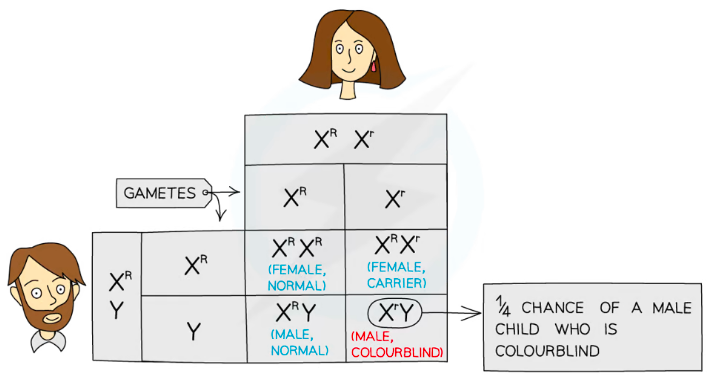Inheritance (3.14-3.21)
Important Definitions
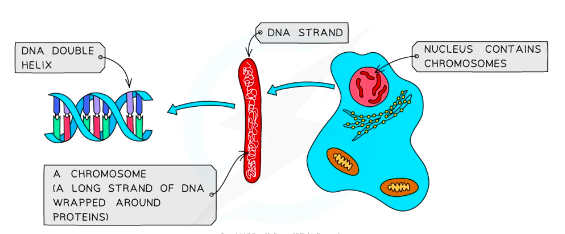
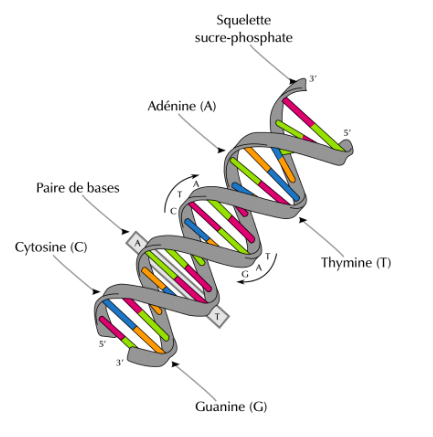
Inheritance: the transmission of genetic information from generation to generation
Chromosomes: A thread of DNA made up of genes
Allele: Alternative version of the same gene
Gene: short length of DNA found on a chromosome that codes for a specific protein
Haploid nucleus: Nucleus containing a single set of unpaired chromosomes (23 in humans)
Diploid nucleus: Nucleus containing pairs of chromosomes (23 pairs in humans/ 46)
Genotype: The combination of alleles that control each characteristic
Phenotype: The observable characteristics of an organism
Homozygous: Pair of identical alleles control the same characteristic
Heterozygous: Pair of dissimilar alleles for a characteristic
Sex Inheritance
One of the 23 pairs of chromosomes codes for sex inheritance
Sex inheritance depends on the presence of X and Y chromosomes
- Males have one X chromosome and one Y chromosome (XY)
- Females have two X chromosomes (XX)
→ Because only a father can pass on a Y chromosome, he determines the child's sex
a genetic diagram (Punnett square), with the X and Y chromosomes can be used to show the inheritance of sex
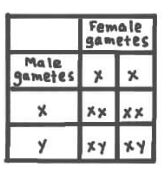
Protein Synthesis:
The base sequence on DNA codes for which amino acids should be joined in what order, to build a particular protein
Proteins are made by ribosomes with the sequence of amino acids controlled by the sequence of bases present in DNA.
DNA can't get from the nucleus to the ribosome , so the basic code for each gene is transcribed onto an RNA molecule called messenger RNA (mRNA).
The mRNA then leaves the nucleus and attaches to the ribosome
Ribosomes "read" the code on the mRNA in groups of three
Each set of three bases codes for a specific amino acid The ribosome converts the base sequence into the amino acid sequence that makes up the protein
Once the amino acid sequence has been assembled, it is released from the ribosome so that it can fold and form the final protein structure
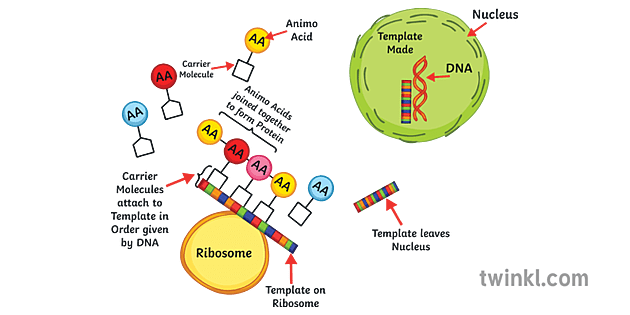
→DNA controls cell function by controlling the production of proteins
The proteins may be enzymes, antibodies, or receptors for neurotransmitters
Cell Division
Mitosis: Nuclear division giving rise to genetically identical cells
- Growth
- Repair
- Cell replacement
Diploid cell (46 chromosomes) undergoing mitosis:
Each chromosome in the nucleus copies itself exactly (forms x - shaped chromosomes)
Chromosomes line up along the centre of the cell where cell fibers pull them apart
The cell divides into two; each new cell has a copy of each of the chromosomes
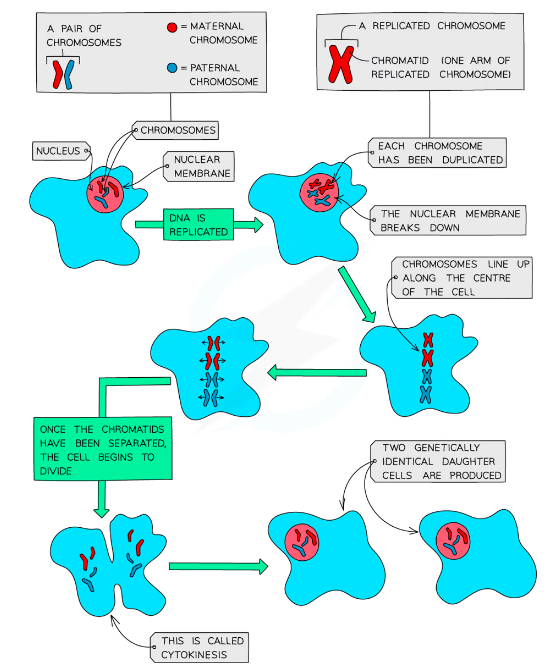
Meiosis: Nuclear division giving rise to cells that are genetically different. This is a reduction division to form haploid cells which produce gametes.
Diploid cell (46 chromosomes) will form haploid cells with 23 chromosomes.
- Each chromosome makes identical copies of itself (forming X-shaped chromosomes)
- First division: chromosomes pair up along the centre of the cell, recombination occurs and then cell fibres will pull the pairs apart, each new cell will have one of each recombinant chromosome pair
- Second division: chromosomes will line up along the centre of the cell, cell fibres will pull them apart (as with mitosis)
A total of four haploid daughter cells will be produced
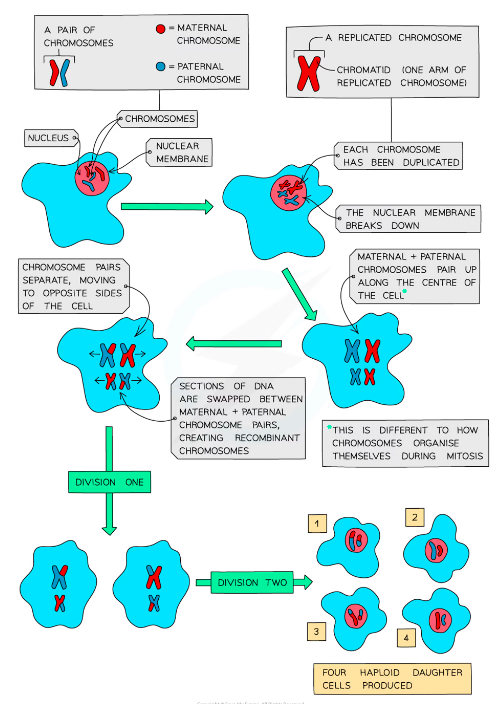
Monohybrid Inheritance \n
Monohybrid inheritance: the inheritance of characteristics controlled by a single gene (mono = one)
Dominant allele - Allele that is always expressed if present
Recessive allele - Allele that is only expressed if the dominant allele is not present
A dominant allele only needs to be inherited from one parent in order for the characteristic to show up in the phenotype
A recessive allele needs to be inherited from both parents in order for the characteristic to show up in the phenotype. \n →An individual could be homozygous dominant, or homozygous recessive or heterozygous
1 recessive and 1 dominant; Dominant is expressed
Both recessive; Recessive is expressed
Both Dominant; Dominant is expressed
Punnet square diagram: Shows the possible combinations of alleles that could be produced in the offspring
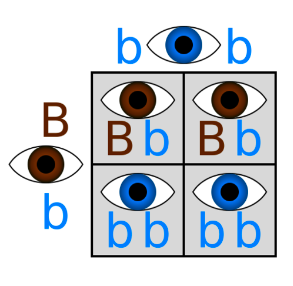
Uppercase letters represent dominant alleles while lowercase letters represent recessive alleles
Ratio of Brown:Blue is 1:1
Codominance
Sometimes, neither of a pair of alleles is completely dominant or completely recessive
Codominance: Both alleles have an effect on the phenotype \n
Blood cells have antigens on their surface
The body will produce antibodies when foreign antigens are detected
Blood Types are an example of codominance
(Each letter represents the antigens on the bloods surface)
Type A has A antigens, Type B has B antigens, Type AB has both A & B antigens, Type O has NO antigens on its surface
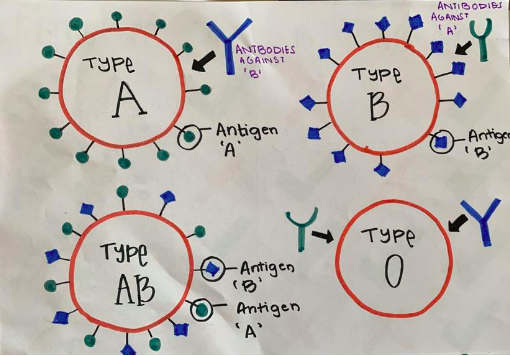
There are three alleles of the gene governing this instead of the usual two
- Alleles IA and IB are codominant, but both are dominant to IO
- I represents the gene and the superscript A, B and O represent the alleles
- IA results in the production of antigen A in the blood
- IB results in the production of antigen B in the blood
- IO results in no antigens being produced in the blood
This is important when finding compatible donors for blood transfusion
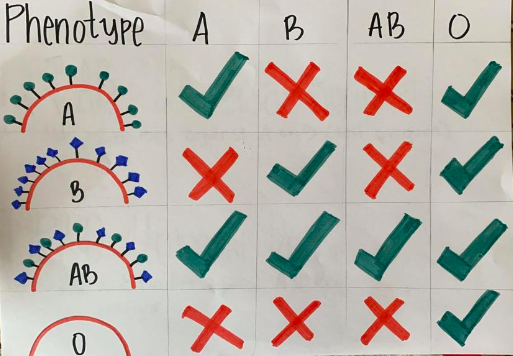
Sex-Linked characteristics
There are only alleles on X chromosomes
Because males only have one X chromosome, they are much more likely to show sex-linked recessive conditions
As females inherit two copies of the X chromosome, one dominant allele masks the recessive one
Carriers are females who do not show the characteristic, but have a 50% chance of passing it on to their offspring.
→If that offspring is a male, he will show the characteristic
